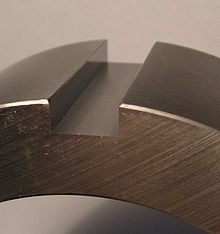Deep grinding
As a variant of the grinding process, deep grinding is a cutting manufacturing process in metalworking with a geometrically undefined cutting edge .
method
In deep grinding (creep speed grinding or full-cut grinding), the allowance to be ground is usually removed in one pass of the grinding tool ( grinding wheel ) through the workpiece to be machined . With deep grinding, high infeed values of up to 15 mm are achieved. In contrast, the feed speed is slow, especially with longer workpieces. Hence the name creep speed grinding. Machining with the same cutting performance using conventional pendulum grinding (surface grinding) would result in a significantly longer machining time, since only low infeed values can be achieved there.
Tool wear
The tool wear is less with deep grinding than with pendulum grinding with the same cutting performance. This means that the grinding wheel does not have to be dressed as often .
Workpiece cooling
Due to the high cutting performance and, at the same time, low workpiece feed, higher temperatures occur at the contact point between the grinding wheel and workpiece than with pendulum grinding. The supply of cooling lubricant must therefore be much stronger; this is usually achieved using high-performance pumps.
Deep grinding is usually done with soft and highly porous grinding wheels.
advantages
The advantages of deep grinding are:
- Shorter processing times with high cutting performance at the same time
- Longer tool life (grinding wheel)
Application example
In the deep grinding process z. B. manufacture a keyway. The grinding wheel must first be precisely calibrated to the required fitting size.
